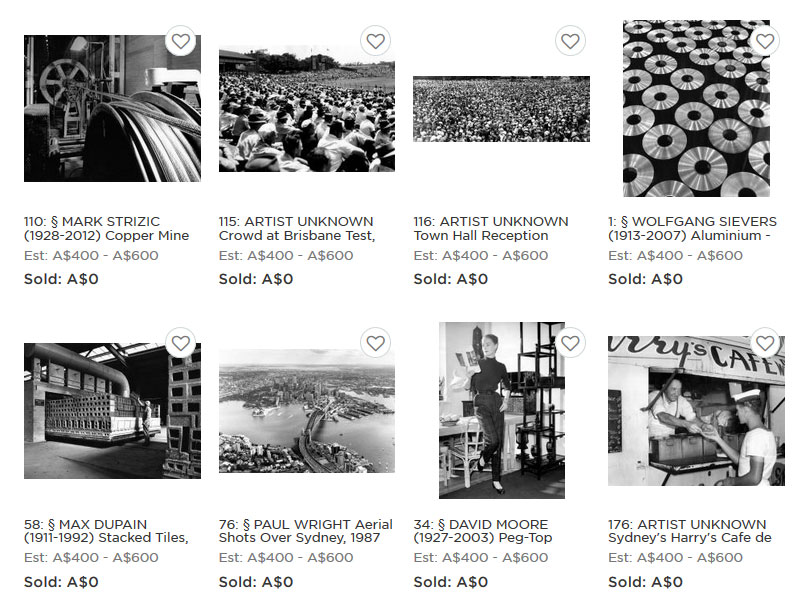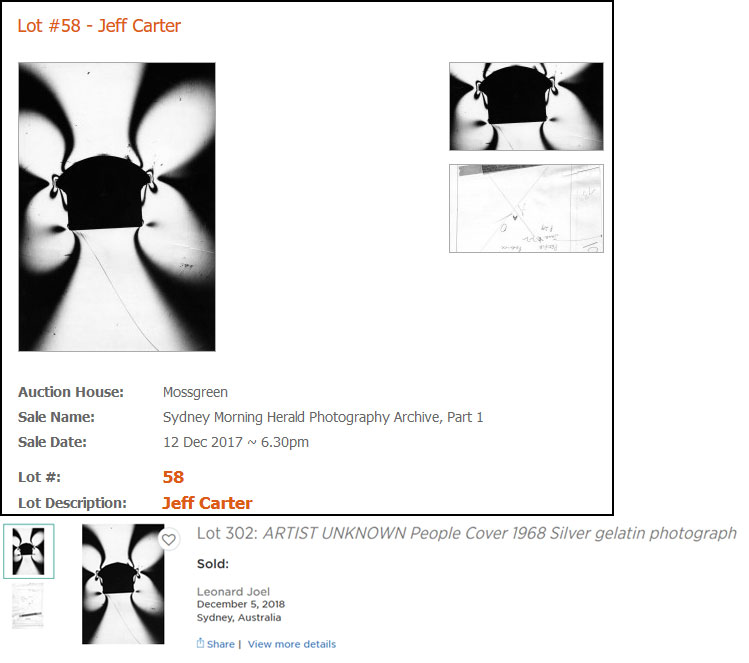A rescued collection of 374 iconic vintage Fairfax photos was recently auctioned in Sydney, but alarming copyright issues and a tough secondary art market for photography deterred buyers.

The auction, held in Sydney on December 5 by auction house Leonard Joel, featured iconic and historic Sydney photos by celebrated Australian photographers such as Olive Cotton, Max Dupain, Wolfgang Sievers, David Moore, Jeff Carter, Frank Hurley, and many others.
It should have been a roaring success, with red dots everywhere. But selling prints produced for newspapers, without intellectual property licensing, is proving a challenge.
‘It was a difficult sale and not massively successful for a number of reasons,’ Hamish Clarke, Leonard Joel’s head of Sydney office, told Inside Imaging. ‘Copyright issues with some works have been a challenge, and we’ve been careful to do the right thing. Only about 90 works sold.’
While the prints came from the Fairfax archive, it’s not the media company selling them. US art dealer Daniel Miller, of Duncan Miller Gallery, acquired the entire two million Fairfax photo archive last year.

Fairfax photos ‘rescued’ from Arkansas
Miller purchased the archive – over two million prints, negatives, and slides – from US bankruptcy lawyers, who seized the collection from a convicted fraud named John Rogers.
Back in 2013 John Rogers cut a deal to digitise the Fairfax archive.
Fairfax, looking for the cheapest method to digitise its archive, sold the physical items to Rogers for $300,000 in exchange for a digital copies of all pictures.
Shortly after the archive arrived in Little Rock, Arkansas, it emerged that Rogers was a fraud – selling fake sports memorabilia on eBay. Fairfax even filed a lawsuit against him after it found Fairfax photos for sale on eBay.
The FBI raided Rogers’ house and warehouse, and he filed for bankruptcy leaving the archive in the possession of liquidators.
The liquidators were planning on separating the archive into segments and selling them on eBay. But Miller swooped in and has been on a quest to sell the photos back to Australian buyers, who are obviously more interested in a ‘pictorial first draft’ of Australia than anyone anywhere else in the world.
The copyright licence for post-1955 pictures is either held by Fairfax, or by the photographers and their estate. It depends on the contract and licensing agreement, and this information isn’t easily accessed.
Many works included in the auction weren’t by Fairfax staff photographers, and some photojournalists would have negotiated strict usage terms and held fast to copyright, such as was the case with Jeff Carter.
‘Fairfax would probably rather this whole collection disappear, I’d imagine,’ Clarke said. ‘What they did was really strange. Quite a few of the photographers could not believe their work was sent overseas, and the staff photographers only really found out about it the day it happened. It was odd.’
Clarke explained that Mossgreen, a now-bankrupt Sydney auction house, was being sued for copyright infringement by The Jeff Carter Archive for republishing pictures in a similar Miller/Fairfax vintage archive auction catalogue.
‘These people (photographers and their estates) have every right to know what’s going on with their work. We tried to call literally everyone we could,’ he explained. ‘Most photographers were fine about it, saying they were on staff and had already been paid. Rex Dupain reasoned that his dad (Max Dupain) was paid for the images, and couldn’t see why he’d have any right to them now.
‘…We [initially] got the bum steer from the [David] Moore Estate but we came to a perfectly reasonable arrangement. The Jeff Carter work was difficult. They will not provide copyright to reproduce images – so they didn’t appear in a catalogue or in e-mails. If you wanted to see them, you’d have to come here.’
Legal proceedings didn’t go ahead against Mossgreen, as the company went bankrupt (not related to the alleged copyright infringement).
Sandra Byron, manager of the Jeff Carter Archive, told Inside Imaging that Jeff Carter never worked as a Fairfax staff photographer and made the utmost efforts to protect his work.

‘Our position is, has been, and remains, that Jeff Carter and now his executives through the Jeff Carter Archive, own all rights associated with Jeff Carter works and will vigorously defend those rights. Jeff Carter was never a staff photographer for Fairfax or any of its mastheads.’
Byron said there were ongoing legal matters regarding copyright ownership, and so they refused the request to display the images. She also highlighted that there was an image which they reproduced as ‘Artist Unknown’ which previously appeared in the Mossgreen catalogue as being a shot by Jeff Carter.
‘We believe they and their vendor were or should have been aware, that this was a work by Jeff Carter as it was previously included in the Mossgreen sale as such.’ she said.
It’s possible Fairfax may not have been legally entitled to sell the photos in 2013, or even store them in an archive up until then. Clarke also speculated this may have been the case.
‘We’re quite extreme about the issue and are saying you basically can’t do anything with the images,’ Clarke said. ‘However it’s a grey area as to whether you can e-mail the image, but we’re not sure so we didn’t do it. It’s not worth upsetting anybody. We can legally sell the image – title has transferred to Duncan Miller Gallery, when he bought the collection from the liquidators in the US. But that doesn’t mean to say he owns the intellectual property of the image.’
Beyond the strict copyright measures, Clarke also pointed out that the photos were made for newspapers – not to be sold at auction as works of art.
‘I wanted iconic Sydney images. They seem to sell and it’s an interesting collection to have here. They’re great images – some really cool ones. But they were produced for the Herald, and not as significant works. There was an Olive Cotton Teacup Dancers, but Olive Cotton had never been near that picture – it was produced well after she passed. So what is it? What is the value?’
He added that the quality of some prints weren’t great. They fell short of having the high standard expected of photographic prints for sale in the secondary market, in which many buyers already have reservations about photography.
‘My knowledge of photography is not vast, but for some of these works I look at them and wonder “What have I got here?”
‘All photography is tricky once you get past a certain age because they weren’t done in editions. How many Sunbakers are there? Who knows. There has been no regulation on it. I was working at Mossgreen at the time when we sold the (Max Dupain) Sunbaker for $104,000. It was meant to be only one of six produced in that size. Well, let’s just say we got offered about five the next day. The Sunbaker never became famous until the ’70s. ‘
The remaining photos have gone to Grace Fine Art, an art and antique management business, for archival storage and protection.
Hey, you read the entire article! There’s plenty more where that came from. If you haven’t already, please subscribe to our free newsletter. No spam, just the facts!





Be First to Comment